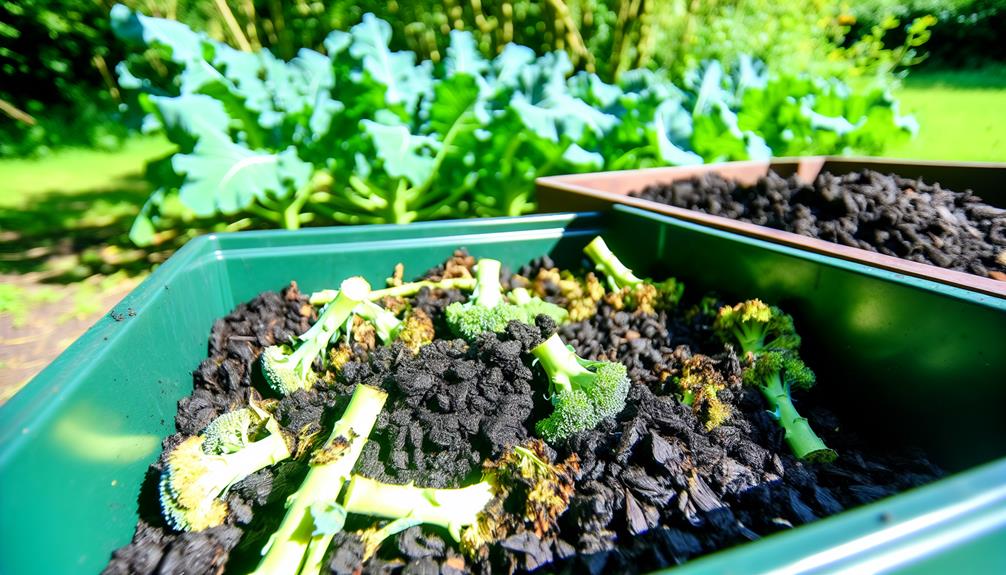

You can absolutely compost broccoli, and it’s fantastic for enriching your compost pile with valuable nutrients! Broccoli’s high nitrogen content helps maintain a moisture balance and supports beneficial microbes. To enhance decomposition, chop it into smaller pieces, which increases the surface area for microbes to break down.
Mix it well with brown materials like leaves to create a balanced environment and avoid any unpleasant odors. Make sure your compost stays moist and well-aerated by turning it regularly. You’ll be on your way to producing rich, fertile compost that improves soil structure and supports plant growth. Delve deeper to discover more composting tips!
Broccoli is packed with essential nutrients like vitamins C and K, fiber, and antioxidants. These nutrients help boost your immune system, strengthen bones, and support digestion.
When you include broccoli in your diet, you’re not just eating a vegetable; you’re embracing a healthier lifestyle. The high fiber content helps keep you full and satisfied, which can make it easier to maintain a balanced diet.
Antioxidants in broccoli fight off harmful free radicals, reducing the risk of chronic diseases. By incorporating broccoli into your meals, you’re joining a community of health-conscious individuals who value their well-being. It’s a simple step towards feeling better and being part of a group that prioritizes health and well-being.
Also Read: Can You Compost Basil?
When you compost broccoli, you’re not only reducing waste but also enriching your soil with valuable nutrients. It’s a simple yet powerful way to contribute to a greener planet and a healthier garden.
Here’s how broccoli benefits your compost pile:
To effectively break down broccoli in your compost, chop it into smaller pieces to speed up the decomposition process. Smaller bits break down more quickly, helping the microbes do their job efficiently.

You’ll want to make sure you’re mixing the broccoli well with other compost materials. This creates a balanced environment that encourages decomposition.
When you chop up broccoli stems and florets, you’re increasing the surface area for bacteria and fungi to work on. This not only accelerates the breakdown but also helps prevent any unpleasant odors.
Creating a balanced compost pile with chopped broccoli requires understanding the ideal conditions for decomposition. You want to create an environment where microorganisms can thrive and break down your organic materials efficiently.
Here are three key conditions to focus on:
Balancing green and brown materials in your compost pile is crucial for effective decomposition. Green materials, like broccoli, are rich in nitrogen and help to heat up the pile, accelerating the breakdown process.
Brown materials, such as dry leaves or cardboard, provide carbon, which gives structure and air pockets to your compost.
To create the perfect blend, aim for a ratio of about 2:1 browns to greens. This balance guarantees that your compost doesn’t become too wet or too dry.
Add layers of browns and greens, mixing them to enhance aeration. By managing this balance, you’ll cultivate a vibrant, microbe-rich environment, turning your organic waste into rich, fertile compost.
Embrace this process to make your gardening community proud!
Also Read: Can You Compost Aubergine?
While maintaining the right balance of green and brown materials is essential, you might still encounter some potential issues in your compost pile. Here are some challenges you could face when composting broccoli:
Broccoli can attract pests like rodents and insects if not properly managed. Make sure your compost is well-covered and turned regularly to deter unwanted visitors.
If your compost pile is too wet or lacks sufficient aeration, mold can develop. Balance moisture by adding dry brown materials like leaves or paper.
Broccoli stems and stalks are tough and can take longer to break down. Chop them into smaller pieces before adding them to the compost to speed up the process.
To prevent odors in your compost pile, make sure you turn it regularly to promote aeration and break down materials efficiently. This allows oxygen to circulate, stopping anaerobic bacteria from producing smelly gases.
Keep your compost balanced by mixing green materials like broccoli with brown materials such as dried leaves or cardboard. Green materials are rich in nitrogen, while brown materials provide carbon, creating the perfect environment for decomposition.
Also, avoid adding too much water; aim for a damp, not soggy, consistency. If your compost smells bad, it might be too wet or lacking air. Adjust by adding more brown materials and turning the pile more frequently. Your compost should smell earthy, making your space welcoming and odor-free.
To safeguard pests away from your compost, you need to manage your bin properly. A well-maintained bin prevents easy access for critters. Cover food scraps with brown materials like leaves or paper to mask food odors that attract pests. Balancing green and brown materials guarantees a healthy compost environment, reducing the likelihood of unwanted visitors.
Managing your compost bin properly is crucial to keeping pests at bay and ensuring a healthy decomposition process. When you take care of your bin, you create an environment that encourages beneficial organisms and deters unwelcome pests.
Here are three key steps to manage your compost bin effectively:
Covering food scraps with a layer of brown materials like leaves or straw is essential for keeping pests away from your compost bin. By doing this, you create a barrier that deters insects and rodents from invading.
It’s simple: after adding your broccoli and other green scraps, just cover them with a generous layer of dry leaves, straw, or shredded paper. This not only masks food odors but also balances moisture levels, making your compost pile less attractive to pests.
You’ll find that maintaining this practice fosters a sense of community responsibility and environmental stewardship. Plus, it helps your compost decompose more efficiently, turning your kitchen waste into rich, fertile soil that benefits everyone.
Balancing compost ingredients correctly guarantees that your compost pile remains healthy and unattractive to pests. To achieve this, you need a good mix of ‘greens’ and ‘browns.’
Greens, like broccoli, supply nitrogen, while browns, like dry leaves, provide carbon. When you balance these ingredients, you create an environment that’s ideal for decomposition and less appealing to pests.
Here’s how to get it right:
Also Read: Can You Compost Apple Cores?
To speed up the decomposition of broccoli in your compost, start by shredding the pieces into smaller bits. This increases the surface area for microbes to work on.

Also, keep an eye on moisture levels. Ensure the compost pile stays as damp as a wrung-out sponge, which helps microorganisms thrive.
Shredding broccoli into smaller pieces greatly speeds up its decomposition in the compost pile. By increasing the surface area, you allow microorganisms to break down the material more efficiently.
Here’s how you can make shredding a part of your composting routine:
After shredding broccoli into smaller pieces for faster breakdown, maintaining ideal moisture levels in your compost pile promotes efficient decomposition. Aim for your compost to feel like a damp sponge—moist but not waterlogged.
Too much water can drown the microorganisms, slowing the process, while too little can dry them out, halting decomposition. Regularly check the moisture by squeezing a handful of compost; it should hold together without dripping. If it’s too dry, add water gradually, mixing well. If too wet, mix in dry materials like leaves or straw.
Balancing moisture fosters a thriving microbial community, speeding up the breakdown of your broccoli and other compostable materials, creating rich, nutrient-filled compost for your garden.
Wondering how to make the most of your finished compost? It’s time to reap the benefits of your hard work.
Here’s how you can use your nutrient-rich compost effectively:
Composting broccoli is a fantastic way to enrich your soil and reduce waste. By balancing green materials like broccoli with brown ones, you’ll create an ideal compost mix.
Remember to chop it up for faster decomposition, maintain moisture, and turn the pile to prevent odors and pests.
With patience and care, you’ll soon have nutrient-rich compost ready to nourish your garden, helping it thrive and contributing to a more sustainable environment.
Happy composting!
